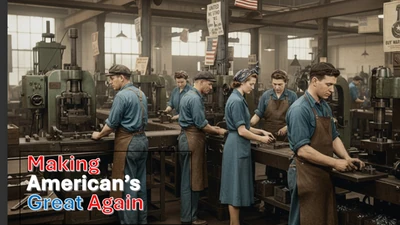I’ve been investing for years, always looking for stability and steady returns, especially in a market that feels like a rollercoaster lately. So, when I see President Trump going after Federal Reserve Chairman Jerome Powell, I can’t help but pay attention. As a conservative, I get why Trump wants to shake things up—he’s fighting for an America First economy, and the Fed’s slow moves on interest rates are frustrating his plans, like those new tariffs from April 2025. But as an investor, I’m worried about what this clash means for my portfolio. Let’s break down Trump’s options, the risks, and what we need to watch for.
Why This Fight Matters to Me
I’ve always admired Trump’s knack for putting American workers first. His tariffs are a bold move to fix trade imbalances—our $1 trillion goods deficit last year shows how much we’ve been taken advantage of. But those tariffs could push prices up, and Trump wants the Fed to cut rates to ease the pain and keep the economy humming. Powell, though, isn’t budging, keeping rates steady to fight inflation. Trump’s called him out, saying he’s “always TOO LATE AND WRONG,” and I get the frustration. The Fed’s independence sounds nice, but as a conservative, I don’t love unelected bureaucrats slowing down a pro-growth agenda. Still, I know the Fed’s job is to keep things stable, and stability is what I need as an investor.
What Trump Can Do: The Legal Side
I dug into what Trump can actually do about Powell, and it’s tricky. The law says the president can remove Fed governors “for cause”—think misconduct or inefficiency, not just because they disagree. That’s based on a 1935 Supreme Court ruling, Humphrey’s Executor, which protects independent agencies. But the chairmanship itself might not have the same protection, leaving a gray area. Some conservative legal minds argue Trump should have more power to fire who he wants—after all, he’s the elected leader. There’s even a Supreme Court case right now about Trump firing other agency heads, and if he wins, he might try to boot Powell.
Here’s the catch: Powell’s chair term ends in May 2026, but he’s a governor until 2028. Trump could try to demote him from chair but keep him on the Board, which would be a mess. The Fed’s rate-setting group, the FOMC, usually picks the chair as its leader, so Powell could fight back and cause chaos. I don’t like uncertainty in my investments, and this kind of drama could spook markets big time.
Trump’s Political Moves: Turning Up the Heat
Trump’s not one to sit quietly, and I respect that. He’s already blasting Powell on social media, calling him a “major loser” for not cutting rates. That’s classic Trump—using public pressure to get what he wants. He did it in his first term, and it worked to some extent. As an investor, I’m torn: I like that he’s holding the Fed accountable, but I worry his attacks could rattle Wall Street. Markets hate unpredictability, and we’ve already seen volatility with the tariff rollout.
Trump can also stack the Fed with his own people over time. The Fed Board has seven seats, and he can fill any openings with folks who share his views—like maybe Kevin Warsh, who’s advised him before. That’s a slower play, but it could shift the Fed’s direction without a legal fight. He might even push Congress to limit the Fed’s independence, though getting 60 votes in the Senate is a long shot. I’d support more accountability, but I’m not holding my breath for a quick fix.
What This Means for My Investments
Here’s where I start sweating. If Trump tries to fire Powell, markets could tank. Senator Elizabeth Warren warned about a crash, and I don’t often agree with her, but she’s got a point—investors like me need confidence. Some X users are saying a Trump loyalist at the Fed could spike inflation or make us look like an “emerging market” with no credibility. That’s a disaster for my bonds and dividend stocks. On the flip side, if Trump gets his way and rates drop, it could boost growth stocks and my real estate holdings. But history—like Nixon bullying the Fed in the ‘70s and causing inflation—makes me nervous.
Powell’s not backing down either. He says Trump can’t fire him, and some Republicans, like Senator John Kennedy, are defending the Fed’s independence. Studies show independent central banks usually deliver better economic outcomes, which is why I’ve always liked the Fed’s steady hand. But I also see Trump’s point: why should an unelected guy like Powell get to slow down an elected president’s agenda? It’s a tough call.
What I’m Watching For
As an investor, I’m keeping my eyes on a few things. First, that Supreme Court case—if Trump wins, he might go after Powell, and I’ll need to brace for market swings. Second, the Fed’s next rate decision. If Powell cuts rates, it might calm Trump down, but if he doesn’t, this fight could get uglier. Third, any new Fed appointments—Trump’s picks could signal where monetary policy is headed. For now, I’m sticking to my conservative strategy: healthcare ETFs, big-cap stocks like Johnson & Johnson, and REITs. They’re safer bets if this feud shakes things up.
The Bottom Line for Us Investors
Trump’s got some legal wiggle room to go after Powell, but it’s risky, and the political pressure he’s already applying might be enough to make a difference. I admire his fight to put America first, but as an investor, I need markets to stay calm. If you’re like me, diversify, stay defensive, and watch this saga closely—it could mean the difference between a good year and a rough one for our portfolios.










